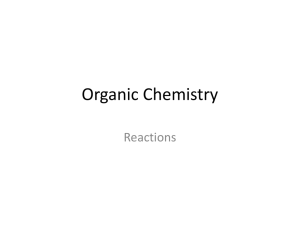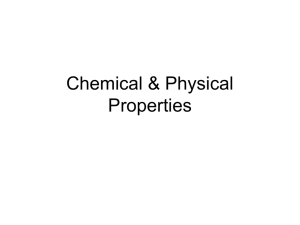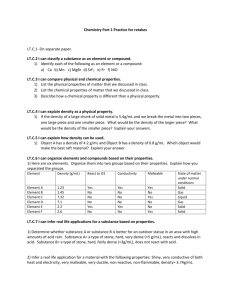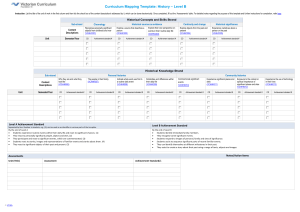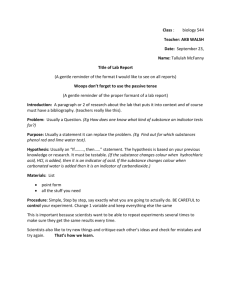ANSWERS: Level 3 Distinguishing between
advertisement
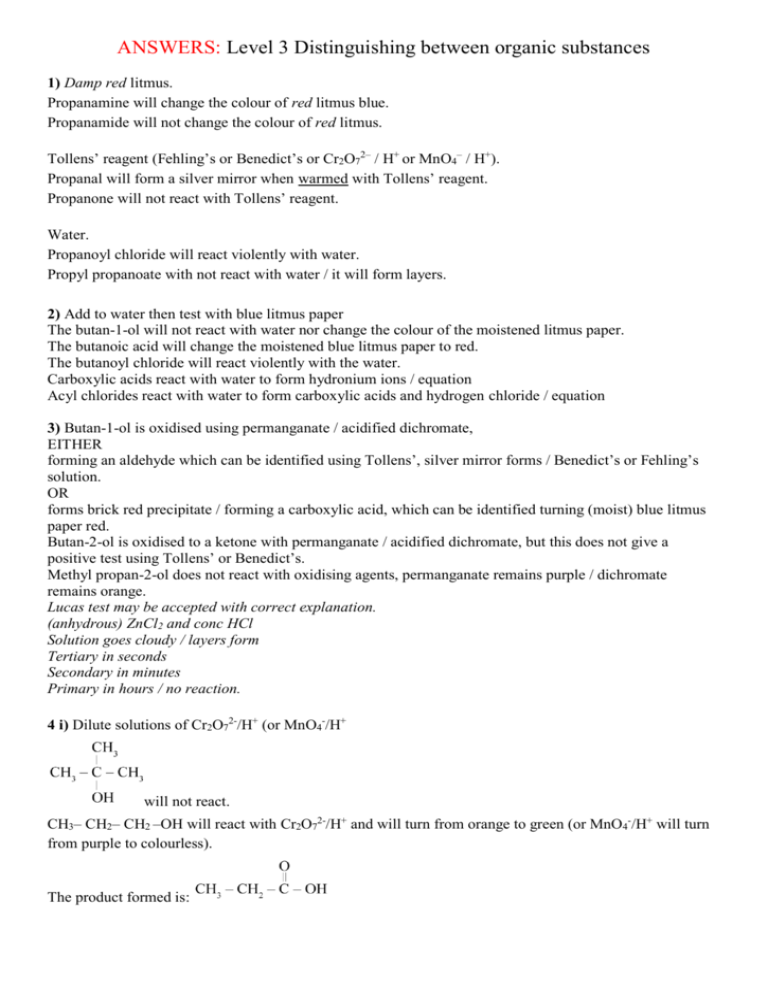
ANSWERS: Level 3 Distinguishing between organic substances 1) Damp red litmus. Propanamine will change the colour of red litmus blue. Propanamide will not change the colour of red litmus. Tollens’ reagent (Fehling’s or Benedict’s or Cr2O72– / H+ or MnO4– / H+). Propanal will form a silver mirror when warmed with Tollens’ reagent. Propanone will not react with Tollens’ reagent. Water. Propanoyl chloride will react violently with water. Propyl propanoate with not react with water / it will form layers. 2) Add to water then test with blue litmus paper The butan-1-ol will not react with water nor change the colour of the moistened litmus paper. The butanoic acid will change the moistened blue litmus paper to red. The butanoyl chloride will react violently with the water. Carboxylic acids react with water to form hydronium ions / equation Acyl chlorides react with water to form carboxylic acids and hydrogen chloride / equation 3) Butan-1-ol is oxidised using permanganate / acidified dichromate, EITHER forming an aldehyde which can be identified using Tollens’, silver mirror forms / Benedict’s or Fehling’s solution. OR forms brick red precipitate / forming a carboxylic acid, which can be identified turning (moist) blue litmus paper red. Butan-2-ol is oxidised to a ketone with permanganate / acidified dichromate, but this does not give a positive test using Tollens’ or Benedict’s. Methyl propan-2-ol does not react with oxidising agents, permanganate remains purple / dichromate remains orange. Lucas test may be accepted with correct explanation. (anhydrous) ZnCl2 and conc HCl Solution goes cloudy / layers form Tertiary in seconds Secondary in minutes Primary in hours / no reaction. 4 i) Dilute solutions of Cr2O72-/H+ (or MnO4-/H+ will not react. CH3– CH2– CH2 –OH will react with Cr2O72-/H+ and will turn from orange to green (or MnO4-/H+ will turn from purple to colourless). The product formed is: ii) Add water will not react. reacts vigorously with an exothermic reaction. The product formed is CH3– COOH. 5) H3C–CH2–CH2–NH2 is propanamine / 1-aminopropane Propanamine will turn damp (red) litmus blue. H3CCH2CH2NH2 + H2O ⇄ H3CCH2CH2NH3+ + OH– H3C–CH2–CHO is propanal. Propanal will react with Tollens’ reagent, forming a silver mirror / precipitate. Reaction: CH3CH2CHO + Ag+ → CH3COOH + Ag (OR half equations) H3C–COCl is ethanoyl chloride. Ethanoyl chloride will react vigorously with water OR Ethanoyl chloride will turn damp (blue) litmus paper red. Reaction: CH3COCl + H2O → CH3COOH + HCl 6) Damp red litmus will turn blue in the presence of the amine but no change with the amide (or clearly indicate solution / add water / aqueous). OR Universal indicator. OR Add Cu2+(aq) the amine will form a deep blue solution and no reaction with the amide. 7) Compound has an aldehyde group. To test for aldehyde group add Tollens’ reagent or Fehlings or Benedicts and heat. Observations for Tollens: The (colourless) solution would form a silver mirror (or black precipitate. Observations for Fehlings or Benedicts: The blue solution changes to a brick red precipitate. No reaction with propanone, which is a ketone. Compound could be further oxidised to form a carboxylic acid using an oxidising agent, the propanone cannot be further oxidised. Acidified dichromate. Colour change orange to green. Acidified permanganate. Colour change purple to colourless. 8) Compound X = CH3CH(OH)COOH (2-hydroxypropanoic acid) Chiral C and acid group reacts with carbonate. Secondary OH oxidised to ketone – if it was primary, then the diacid would form. Compound Y = CH3COCOOH – no chiral C. Acid group still reacts. It is the product of the oxidation of the secondary alcohol, (evidence may be drawn from the equation). 9) The liquid is 3-methyl butan-1-ol No enantiomers – cannot be a branched chain secondary alcohol or 2-methylbutan-1-ol Reaction with acidified dichromate – cannot be a branched chain tertiary alcohol as tertiary alcohols cannot be oxidised Reaction with conc. H2SO4 is an elimination reaction – cannot be 2,2,dimethyl propan–1–ol as there is no H on C adjacent to the C with –OH. (no double bond/alkene can form because of the three C-C bonds) 10) The amine will turn red litmus blue. On addition of acidified permanganate solution, the propanoyl chloride will react violently and the pentanal will react to decolourise the solution. 4-chlorobutanoic acid will not react. 11) Propanoic acid can be identified as it turns damp blue litmus paper red or produces a gas with a metal carbonate or bicarbonate. Neither propan-1-ol nor propanal change the colour of litmus paper or react with the carbonate or bicarbonate. Propanal will form a brick-red ppt with Benedict’s or Fehling solutions or a silver mirror with Tollens’ reagent, but propan-1-ol will not. OR use acidified dichromate or acidified permanganate which will not react with the acid but will oxidise both the alcohol and aldehyde and turn the orange Cr2O72- green or purple MnO4- to colourless. OR In reverse identify aldehyde first (as above) then use litmus or Cr 2O72-/H+ or MnO4-/H+ to identify acid or alcohol respectively. 12) 1. Add bromine water Violent reaction – acid chloride. Decolourises instantly – hex-1-ene. The hex-1-ene is insoluble and forms 2 layers. 2. Add Cr2O72– / H+ if substance soluble. Ethanol will change the dichromate from orange to green. Methyl propanol will not react. 13) i) Only the propanal will react with Tollens’, Fehling’s or Benedict’s reagents. The aldehyde reduces Tollens’ reagent producing a silver mirror on the side of the test tube (on warming); reduces Benedict’s soln, colour change blue to brick-red ppt; (similar for Fehling’s). There is no reaction with the butan-2-ol. ii) Only the butanoyl chloride will form a solution and react with water to form an acidic solution, which can be tested with blue litmus paper, which turns red. The haloalkane is insoluble in water and does not change the colour of blue litmus paper. 14) a) Only the propanal will react with Tollens’, Fehling’s or Benedict’s. The aldehyde reduces Tollens’ reagent producing a silver mirror on the side of the test tube (on warming); reduces Benedict’s soln, colour change blue to brick-red ppt; (similar for Fehling’s). b) The amine CH3CH2NH2 is a weak base, it will dissolve in water to give a basic solution, the amide forms a neutral solution when dissolved in water e.g. litmus solution changes colour from red to blue when placed in an alkaline solution. / amines form deep blue coloured complex ions with copper(II), amides do not. © 2015 http://www.chemicalminds.wikispaces.com NCEA questions and answers reproduced with permission from NZQA
